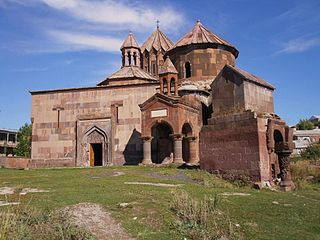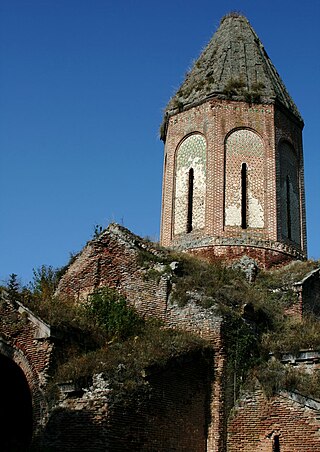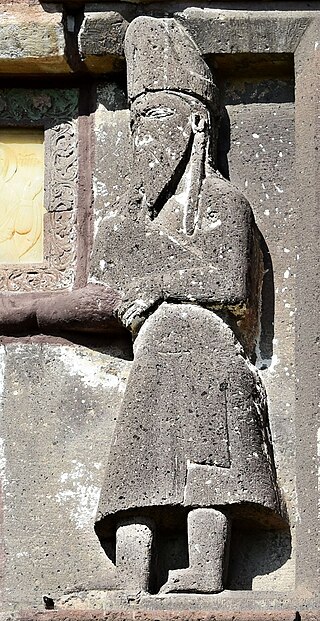
The Orbelian lords of the province of Syunik were a noble family of Armenia, with a long history of political influence documented in inscriptions throughout the provinces of Vayots Dzor and Syunik, and recorded by the family historian Bishop Stepanos in his 1297 History of Syunik.

The Zakarid dynasty, also Zakarids or Zakarians were a noble Armenian dynasty, rulers of Zakarid Armenia (1201–1350) under the suzerainty of the Kingdom of Georgia, and from 1256 under the control of the Mongol Ilkhanate of Persia. Their dynastic name was formed in honour of Zakare, the famous servant of the Georgian Queen Tamar. They were also known by their Georgian nickname Mkhargrdzeli. A family legend says that this name was a reference to their Achaemenid ancestor Artaxerxes II the "Longarmed". According to Cyril Toumanoff / Encyclopædia Iranica, they were an offshoot of the Armenian Pahlavuni family. The Zakarians considered themselves Armenians.

Ani is a ruined medieval Armenian city now situated in Turkey's province of Kars, next to the closed border with Armenia.

The Harichavank is 7th century Armenian monastery located near the village of Harich in the Shirak Province of Armenia. The village is 3 km southeast of the town of Artik.

Kobayr is a 12th-century Armenian monastery located in the village Kobayr, directly across the road from the town of Tumanyan, within Lori marz, Armenia.

Akhtala, also known as Pghindzavank is a 10th-century Armenian Apostolic monastery located in the town of Akhtala in the marz of Lori, 185 kilometers (115 mi) north of Yerevan and 87 kilometers south of Tbilisi. The monastery is currently inactive. The fortress played a major role in protecting the north-western regions of Armenia (Gugark) and is among the most well preserved of all in modern Armenia. The main church at the compound is famous for its highly artistic frescoes, which cover the inside walls, the partitions, and the bearings of the building. The frescoes of Akhtala Monastery, in Armenian-Chalcedonian style, were commissionned by the Zakarid ruler Ivane I Zakarian in 1205-1216.

Kirants Monastery is an 8th-century Armenian monastery located about 10 kilometers southwest of Kirants village in the Tavush Province of Armenia. The Georgian Orthodox Church in Armenia has laid claim to the monastery, which the Armenia Apostolic Church rejects.

Zakarid Armenia alternatively known as the Zakarid Period, describes a historical period in the Middle Ages during which the Armenian vassals of the Kingdom of Georgia were ruled by the Zakarid-Mkhargrzeli dynasty. The city of Ani was the capital of the princedom. The Zakarids were vassals to the Bagrationi dynasty in Georgia, but frequently acted independently and at times titled themselves as kings. In 1236, they fell under the rule of the Mongol Empire as a vassal state with local autonomy.

Zakare II Zakarian or Zakaria II Mkhargrdzeli, was an Armenian Court official of the Kingdom of Georgia, holding the office of amirspasalar (Commander-in-Chief) of the Georgian army for Queen Tamar of Georgia during the late 12th and early 13th centuries. He was a member of the Zakarid dynasty, and ruler of feudal lands in the Kingdom of Georgia.
Avag Zakarian or Avag Mkhargrdzeli was an Armenian noble of the Zakarid line, and a Court official of the Kingdom of Georgia, as atabeg and amirspasalar of Georgia from 1227 to 1250.

Zakare III Zakarian or Zakaria III Mkhargrdzeli was a 13th century Armenian noble and a Court official of the Kingdom of Georgia, holding the position of amirspasalar (Commander-in-Chief) for the Georgian army.

Menucihr Mosque is a mosque in the medieval city of Ani in Kars Province, Turkey. It was built between 1072 and 1086 by Manuchihr ibn Shavur of the Kurdish Shaddadid dynasty. Restoration of the mosque started in June 2020.

Kayan Berd is a fortress and a former monastery of the Armenian Apostolic Church in the province of Lori in Northern Armenia.

The Caravanserai of Zor is a 13th-century Armenian caravanserai located 35 kilometers southwest of modern-day Iğdır. Built during the period of Zakarid Armenia, it was commissioned by the Zakarian-Mkhargrdzeli princes and designed by an Armenian architect named Ashot. It was an important stop in the trade routes to the city of Ani and the Silk Road.

Ivane Zakarian was an Armenian Prince of the Zakarid dynasty, the son of Sargis Zakarian, and the younger brother and successor of Zakare II Zakarian. He was a Court official of the Kingdom of Georgia, holding the offices of Msakhurtukhutsesi (Majordomo) and Atabeg for Queen Tamar of Georgia during the early 13th centuries. He was also ruler of feudal lands in the Kingdom of Georgia.

Shahnshah Zakarian was a member of the Armenian Zakarid dynasty, and a Court official of the Kingdom of Georgia, holding the office of amirspasalar (Commander-in-Chief) of the Georgian army. He was the son of Zakare II Zakarian, and the father of Zakare III Zakarian, who participated to the Siege of Baghdad in 1258.
Tigran Honents was a rich Armenian trader of the early 13th century, during the Zakarid period. He is especially known for his dedication of the Church of St Gregory of Tigran Honents in Ani, in Turkey's province of Kars next to the closed border with Armenia in 1215.

The Church of Saint Elia also Zakare's church, is located in Kizkale, near Ani in Turkey. It was built by the Zakarids in the early 13th century, as well as the nearby church of Tigran Honents.
Sargis Zakarian was a founder of the Zakarids–Mkhargrdzeli line. He was a Court official of the Kingdom of Georgia, holding the offices of Amirspasalar (Commander-in-Chief) for Queen Tamar of Georgia during the late 12th century. He was also ruler of feudal lands in the Kingdom of Georgia. He had two particularly famous sons: Ivane I Zakarian and Zakare II Zakarian. were the famous

The Church of the Holy Apostles, also Surp Arak’elots, is an important ecclesiastical monument of the ruined city of Ani, modern Turkey, on the border with Armenia.
































